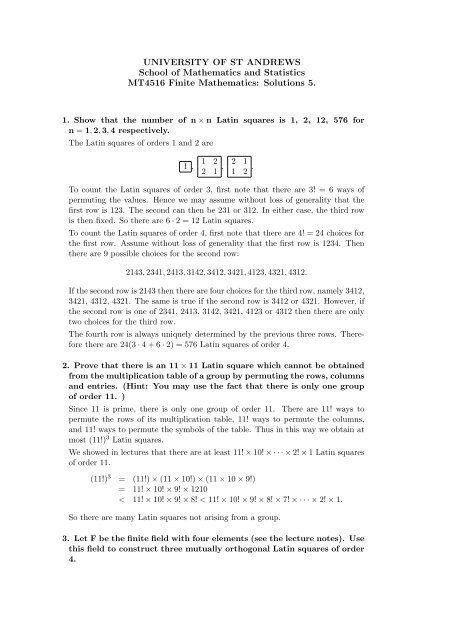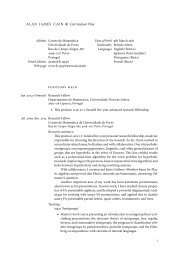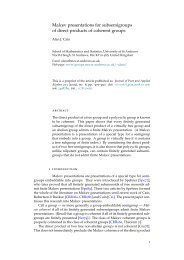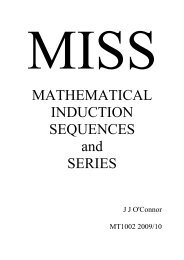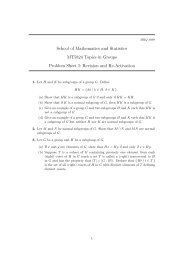Solutions 5. - University of St Andrews
Solutions 5. - University of St Andrews
Solutions 5. - University of St Andrews
You also want an ePaper? Increase the reach of your titles
YUMPU automatically turns print PDFs into web optimized ePapers that Google loves.
UNIVERSITY OF ST ANDREWS<br />
School <strong>of</strong> Mathematics and <strong>St</strong>atistics<br />
MT4516 Finite Mathematics: <strong>Solutions</strong> <strong>5.</strong><br />
1. Show that the number <strong>of</strong> n × n Latin squares is 1, 2, 12, 576 for<br />
n = 1, 2, 3, 4 respectively.<br />
The Latin squares <strong>of</strong> orders 1 and 2 are<br />
1 ,<br />
1 2<br />
2 1 , 2 1<br />
1 2 .<br />
To count the Latin squares <strong>of</strong> order 3, first note that there are 3! = 6 ways <strong>of</strong><br />
permuting the values. Hence we may assume without loss <strong>of</strong> generality that the<br />
first row is 123. The second can then be 231 or 312. In either case, the third row<br />
is then fixed. So there are 6 · 2 = 12 Latin squares.<br />
To count the Latin squares <strong>of</strong> order 4, first note that there are 4! = 24 choices for<br />
the first row. Assume without loss <strong>of</strong> generality that the first row is 1234. Then<br />
there are 9 possible choices for the second row:<br />
2143, 2341, 2413, 3142, 3412, 3421, 4123, 4321, 4312.<br />
If the second row is 2143 then there are four choices for the third row, namely 3412,<br />
3421, 4312, 4321. The same is true if the second row is 3412 or 4321. However, if<br />
the second row is one <strong>of</strong> 2341, 2413, 3142, 3421, 4123 or 4312 then there are only<br />
two choices for the third row.<br />
The fourth row is always uniquely determined by the previous three rows. Therefore<br />
there are 24(3 · 4 + 6 · 2) = 576 Latin squares <strong>of</strong> order 4.<br />
2. Prove that there is an 11 × 11 Latin square which cannot be obtained<br />
from the multiplication table <strong>of</strong> a group by permuting the rows, columns<br />
and entries. (Hint: You may use the fact that there is only one group<br />
<strong>of</strong> order 11. )<br />
Since 11 is prime, there is only one group <strong>of</strong> order 11. There are 11! ways to<br />
permute the rows <strong>of</strong> its multiplication table, 11! ways to permute the columns,<br />
and 11! ways to permute the symbols <strong>of</strong> the table. Thus in this way we obtain at<br />
most (11!) 3 Latin squares.<br />
We showed in lectures that there are at least 11! × 10! × · · · × 2! × 1 Latin squares<br />
<strong>of</strong> order 11.<br />
(11!) 3 = (11!) × (11 × 10!) × (11 × 10 × 9!)<br />
= 11! × 10! × 9! × 1210<br />
< 11! × 10! × 9! × 8! < 11! × 10! × 9! × 8! × 7! × · · · × 2! × 1.<br />
So there are many Latin squares not arising from a group.<br />
3. Let F be the finite field with four elements (see the lecture notes). Use<br />
this field to construct three mutually orthogonal Latin squares <strong>of</strong> order<br />
4.
Recall that the addition and multiplication tables for F are:<br />
+ 0 1 x x + 1<br />
0 0 1 x x + 1<br />
1 1 0 x + 1 x<br />
x x x + 1 0 1<br />
x + 1 x + 1 x 1 0<br />
× 0 1 x x + 1<br />
0 0 0 0 0<br />
1 0 1 x x + 1<br />
x 0 x x + 1 1<br />
x + 1 0 x + 1 1 x<br />
Let f 1 = 1, f 2 = x, f 3 = x + 1 and f 4 = 0. The formula for the squares<br />
A k = (a (k)<br />
ij ) 4×4, for k = 1, 2, 3 is a (k)<br />
ij<br />
= f i f k + f j .<br />
So a (1)<br />
ij<br />
= f i + f j .<br />
a (2)<br />
ij<br />
= f i · x + f j .<br />
a (3)<br />
ij<br />
= f i · (x + 1) + f j .<br />
After renaming the symbols:<br />
A 1 =<br />
1 x 1 + x 0<br />
1 0 x + 1 x 1<br />
x x + 1 0 1 x<br />
1 + x x 1 0 x + 1<br />
0 1 x x + 1 0<br />
f i xf i 1 x 1 + x 0<br />
1 x 1 + x 0 1 x<br />
x x + 1 x 1 0 x + 1<br />
x + 1 1 0 x + 1 x 1<br />
0 0 1 x x + 1 0<br />
4 3 2 1<br />
3 4 1 2<br />
2 1 4 3<br />
1 2 3 4<br />
f i (x + 1)f i 1 x x + 1 0<br />
1 x + 1 x 1 0 x + 1<br />
x 1 0 x + 1 x 1<br />
x + 1 x x + 1 0 1 x<br />
0 0 1 x x + 1 0<br />
, A 2 =<br />
3 4 1 2<br />
2 1 4 3<br />
4 3 2 1<br />
1 2 3 4<br />
, A 3 =<br />
2 1 4 3<br />
4 3 2 1<br />
3 4 1 2<br />
1 2 3 4<br />
4. Prove that there is no Latin square orthogonal to the square<br />
A =<br />
1 2 3 4<br />
2 4 1 3<br />
3 1 4 2<br />
4 3 2 1<br />
Assume that B = (b ij ) 4×4 is orthogonal to A. We may assume without loss <strong>of</strong><br />
generality that B is in standard form, so that b 11 = 1, b 12 = 2, b 13 = 3, b 14 = 4.<br />
There are two possible choices for b 21 : either b 21 = 3 or b 21 = 4 since (a 12 , b 12 ) =<br />
(2, 2). If b 21 = 3 then we deduce that b 22 = 1, b 24 = 2, b 23 = 4, b 31 = 4, b 32 = 3,<br />
b 33 = 2, b 34 = 1. After this there is no possibility for b 41 .<br />
If b 21 = 4 then b 31 = 2, b 41 = 3, b 23 = 2 and then there is no possible value for b 44 .<br />
<strong>5.</strong> Construct two orthogonal Latin squares <strong>of</strong> order 12. (Hint: Use direct<br />
products.)<br />
.<br />
.
Take two orthogonal Latin squares <strong>of</strong> order 4, say A 1 and A 2 from Q3, and two<br />
orthogonal Latin squares <strong>of</strong> order 3, say<br />
The direct products are:<br />
B =<br />
1 2 3<br />
2 3 1<br />
3 1 2<br />
, C =<br />
1 2 3<br />
3 1 2<br />
2 3 1<br />
.<br />
A 1 ×B =<br />
B 4 B 3 B 2 B 1<br />
B 3 B 4 B 1 B 2<br />
=<br />
B 2 B 1 B 4 B 3<br />
B 1 B 2 B 3 B 4<br />
10 11 12 7 8 9 4 5 6 1 2 3<br />
11 12 10 8 9 7 5 6 4 2 3 1<br />
12 10 11 9 7 8 6 4 5 3 1 2<br />
7 8 9 10 11 12 1 2 3 4 5 6<br />
8 9 7 11 12 10 2 3 1 5 6 4<br />
9 7 8 12 10 11 3 1 2 6 4 5<br />
4 5 6 1 2 3 10 11 12 7 8 9<br />
5 6 4 2 3 1 11 12 10 8 9 7<br />
6 4 5 3 1 2 12 10 11 9 7 8<br />
1 2 3 4 5 6 7 8 9 10 11 12<br />
2 3 1 5 6 4 8 9 7 11 12 10<br />
3 1 2 6 4 5 9 7 8 12 10 11<br />
A 2 ×C =<br />
C 3 C 4 C 1 C 2<br />
C 2 C 1 C 4 C 3<br />
=<br />
C 4 C 3 C 2 C 1<br />
C 1 C 2 C 3 C 4<br />
These are orthogonal Latin squares <strong>of</strong> order 12.<br />
7 8 9 10 11 12 1 2 3 4 5 6<br />
9 7 8 12 10 11 3 1 2 6 4 5<br />
8 9 7 11 12 10 2 3 1 5 6 4<br />
4 5 6 1 2 3 10 11 12 7 8 9<br />
6 4 5 3 1 2 12 10 11 9 7 8<br />
5 6 4 2 3 1 11 12 10 8 9 7<br />
10 11 12 7 8 9 4 5 6 1 2 3<br />
12 10 11 9 7 8 6 4 5 3 1 2<br />
11 12 10 8 9 7 5 6 4 2 3 1<br />
1 2 3 4 5 6 7 8 9 10 11 12<br />
3 1 2 6 4 5 9 7 8 12 10 11<br />
2 3 1 5 6 4 8 9 7 11 12 10<br />
6. A Latin square is said to be self-orthogonal if it is orthogonal to its<br />
own transpose.<br />
We let A T = (b ij ) n×n where b ij = a ji .<br />
(i) Prove that if A = (a ij ) n×n is a self-orthogonal Latin square then all<br />
the entries a ii , 1 ≤ i ≤ n, are distinct.<br />
If a ii = a jj then (a ii , b ii ) = (a ii , a ii ) = (a jj , a jj ) = (a jj , b jj ), which contradicts<br />
self-orthogonality.<br />
(ii) Prove that there are no self-orthogonal Latin squares <strong>of</strong> order 3;<br />
find a self orthogonal Latin square <strong>of</strong> order 4.<br />
Assume that A = (a ij ) 3×3 is self-orthogonal. By permuting the symbols if<br />
necessary, we may assume without loss <strong>of</strong> generality that a 11 = 1, a 12 = 2<br />
.
and a 13 = 3. From part (i) it then follows that a 22 = 3 and a 33 = 2. But then<br />
there is no possibility for a 21 , since a 11 = 1 so a 21 ≠ 1, a 12 = 2 so a 21 ≠ 2<br />
and a 22 = 3 so a 21 ≠ 3.<br />
We use similar arguments to construct the following self-orthogonal Latin<br />
square <strong>of</strong> order 4:<br />
1 2 3 4<br />
4 3 2 1<br />
.<br />
2 1 4 3<br />
3 4 1 2<br />
(iii) Prove that the direct product <strong>of</strong> two self-orthogonal Latin squares is<br />
again a self-orthogonal Latin square. (Hint: You may use (A × B) T = A T × B T ).<br />
If A is orthogonal to A T and if B is orthogonal to B T then A×B is orthogonal<br />
to A T × B T = (A × B) T .<br />
(iv) Let n > 3 be a prime power, and let F = {f 1 , f 2 , . . . , f n } be the finite<br />
field with n elements. For an arbitrary t ∈ F, with t ≠ 0, 1 and<br />
t + t ≠ 1, define an array A t = (a ij ) n×n by a (t)<br />
ij<br />
= tf i + (1 − t)f j . Prove<br />
that A t is a self orthogonal Latin square.<br />
First we show that A t is a Latin square. If a (t)<br />
ij<br />
= a (t)<br />
ik<br />
then<br />
tf i + (1 − t)f j = tf i + (1 − t)f k<br />
so (1 − t)f j = (1 − t)f k and hence f j = f k and so j = k. So there are no<br />
repeats in any row.<br />
If a (t)<br />
ij<br />
= a (t)<br />
kj then<br />
tf i + (1 − t)f j = tf k + (1 − t)f j<br />
so tf i = tf k and hence f i = f k and i = k. So there are no repeats in any<br />
column and A t is a Latin square.<br />
Now we show that A t is self-orthogonal. Suppose that (a (t)<br />
ij , a(t) ji ) = (a(t)<br />
Then<br />
Equation (1) implies that<br />
Substituting into (2) we get:<br />
tf i + (1 − t)f j = tf k + (1 − t)f l (1)<br />
tf j + (1 − t)f i = tf l + (1 − t)f k (2)<br />
f i = t −1 (tf k + (1 − t)f l + (t − 1)f j )<br />
= f k + t −1 (1 − t)f l + t −1 (t − 1)f j .<br />
kl , a(t) lk ).<br />
tf j + f k + t −1 (1 − t)f l + t −1 (t − 1)f j − tf k − (1 − t)f l − (t − 1)f j = tf l + (1 − t)f k<br />
⇒ f j (t + 1 − t −1 − t + 1) = f l (1 − t −1 − t + 1 + t)<br />
⇒ f j (2 − t −1 ) = f l (2 − t −1 )<br />
⇒ f j (2t − 1) = f l (2t − 1).<br />
Since 2t ≠ 1 we deduce that f j = f l . Then (1) ⇒ f i = f k . So i = k and j = l.


